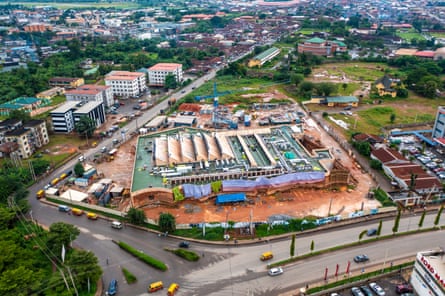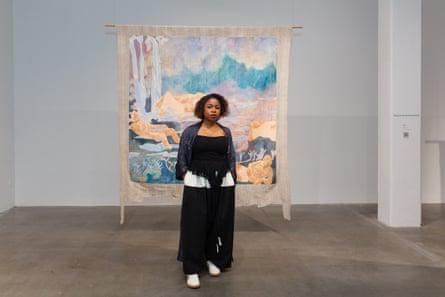Benin City in modern-day Nigeria was once the capital of a bustling kingdom which left a magnificent artistic legacy of plaques and sculpture in cast bronze which were looted by British colonial forces in 1897.
Now, as an increasing number of western museums are returning artefacts, or pledging to repatriate them, the south Nigerian city is getting a new museum that will put to rest the idea that “Africa has no space and capacity to look after its heritage,” says Shadreck Chirikure, professor of archaeological science at the University of Oxford, and adviser to the new museum.
The Museum of West African Art (Mowaa), a constellation of buildings and outdoor performance spaces spread out across a 6-hectare (15-acre) campus, will hold its inaugural exhibition in May 2025.
While Mowaa will not be the home of the returned bronzes, the impetus that led to its establishment was to address the deficit in infrastructure that has hindered restitution efforts, says the museum.
This month, Mowaa held what it called “the hard hat opening” of its institute building, a research, conservation and collections centre equipped with climate-controlled storage rooms, cutting-edge labs and exhibition spaces. A series of workshops and live archaeological excavations were held to introduce visitors to Mowaa, and “start an open dialogue on what it means to be an African museum in the 21st century”.
Chirikure says that Mowaa has the potential “to be among the best in the world for holding returning objects”.
 View image in fullscreen
View image in fullscreen
“It used to be argued that Africa has no space and capacity to look after its heritage,” he says. “If there were those who did not believe in the vision or that Africans can do it, the opening of the institute demonstrates that Mowaa is now a reality, and that contemporary Africans, like their ancestors who made the famous Benin bronzes, are capable of looking after their heritage using the highest standards found anywhere in the world.”
There are two adjoining galleries in the institute, the atrium and special exhibition gallery. The atrium, expected to open in mid-2025, will be largely fixed, hosting Mowaa’s long-term collection, showcasing archaeological finds alongside historical treasures, while the special exhibition gallery will be used for rotating temporary shows.
Some of the works that will be shown at the institute include an ibwese, a large, carved and painted wooden thumb piano featuring human, antelope and cat-like forms, and bronze works from the middle Niger civilisations, including an arresting pendant of complex iconography dated between the 13th and 15th century from Mali.
Mowaa is an excellent example of what happens when Africans decide to give back to Africa, and to work with others to create lasting legaciesShadreck Chirikure, University of Oxford
Nengi Omuku, a Lagos-based visual artist who specialises in abstract paintings that draw from the natural world, describes Mowaa’s arrival as “truly a significant moment in our history” because “it’s a great opportunity for artists to access art we have admired for so long but may have only seen in books”.
The museum, which is independent and not for profit, has received funding from a range of sources including the German government, the Mellon Foundation and the British Museum.
“Mowaa is more than a cultural institution,” says Phillip Ihenacho, its executive director. “It is a vital centre for economic opportunity, community development and supporting and celebrating West Africa’s diverse creative energy across a broad range of disciplines.”
 View image in fullscreen
View image in fullscreen
Ore Disu, director of the Mowaa Institute, says that she took up her post “with a strong sense that we should create something that gives Black and African people a sense of their place in the world”.
“Museums are repositories of our humanity – our relationships, our way of life, our worldview, our connection with the Earth and the supernatural, our hopes for the future,” she says. “This is why the destruction and displacement of cultural material is so detrimental. It robs whole parts of society of a grounded way to articulate their sense of self. It threatens the very roots of our self-esteem.”
The international tide is turning on the restitution of looted art, with museums in the UK, Germany and the US already returning or pledging to return items, despite stalemates at bigger institutions such as the British Museum, which has more than 900 Benin bronzes in its collection.
skip past newsletter promotionSign up to Global Dispatch
Get a different world view with a roundup of the best news, features and pictures, curated by our global development team
after newsletter promotion
An Oba’s head and cockerel, and a brass plaque and wooden altarpiece are among Benin bronzes already returned to Nigeria, but not held at Mowaa.
Disu, who was born and raised in Lagos, says that Mowaa’s vision is to reverse “a sense of disconnect [that] is palpable” in the museums that already exist in west Africa.
“While underfunding plays a role, many museums also have been slow to reinvent themselves for contemporary audiences, often remaining the clunky memorabilia of colonial systems of accumulation and nationalist narratives,” she says.
 View image in fullscreen
View image in fullscreen
“Rather than a single monolithic museum, we are developing a campus with multiple exhibition spaces connected by memorial gardens and performance areas. This layout is inspired by historic Benin City, where guilds and entrepreneurial communities were woven into the ancient walled complex.”
Disu calls the institute “Mowaa’s brainbox”. The building, which will feature a 100-seat auditorium, conference rooms, conservation laboratories and a library, is made from rammed earth, a warm red material symbolic of Benin’s traditional architecture.
Other key parts of Mowaa, including a rainforest gallery and an art guesthouse, will be commissioned within the next year or two, pending further funding. The rainforest gallery, spanning 1,400 sq m, will be an exhibition building for larger displays of contemporary art in a replanted rainforest.
 View image in fullscreen
View image in fullscreen
“The Mowaa Institute is a first-of-its-kind space dedicated to world-class, cutting-edge science research to develop new narratives and to conserve African art and collections,” Chirikure says. “[We] will train a new generation of African researchers at home, using best standards and cutting edge [techniques] on home soil while generating new and interdisciplinary information about the African past. This is fundamental for rewriting African histories by Africans using tools at home and homegrown talent.
“Mowaa is an excellent example of what happens when Africans decide to give back to Africa, and to work with others to create lasting legacies in the museum and heritage space,” he adds.
∎